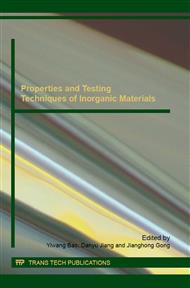p.402
p.406
p.411
p.420
p.429
p.435
p.439
p.447
p.451
Effect of Fly Ash Composition and Structure on the Formation of Cement Clinker
Abstract:
In the view of scarce of natural mineral resources and requirement of energy-saving/emission-reducing for cement industry, the natural silicon-aluminum clay as one cement raw material has been gradually replaced by silica-rich industrial wastes, such as, fly ash, a principal solid waste discharged from coal-fired power plants, composed mainly of silica- and alumina-rich glass bead-shaped mineral. Using fly ash to produce cement raw materials, the formation and chemical reactions of cement clinker are affected by the chemical and mineral composition as well as the texture of the fly ash and the paper was focused on it. The empirical formula for formation heat of fly ash-doped cement clinker is revised on the basis of chemical thermodynamics. The results show that with the use of fly ash, in contrast with the traditional ingredients, the formation of varieties of clinker minerals as well as the formation sequence and types of intermediates varied little, while the maximum decomposition temperature of carbonate was lowered by 50 °C approximately, so that both the solid phase reaction temperature and liquid phase sintering point were decreased, which is favorable to the reduction of clinker formation heat. The revised formation heat empirical formula of fly ash-doped clinker could facilitate the thermal calculation of furnaces and the evaluation of thermal efficiency.
Info:
Periodical:
Pages:
429-434
Citation:
Online since:
February 2016
Authors:
Price:
Сopyright:
© 2016 Trans Tech Publications Ltd. All Rights Reserved
Share:
Citation:


